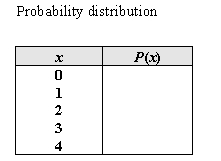The famous physicist, Ernest Rutherford, was a pioneer in the study of radioactivity using electricity. In one experiment he observed the number of particles reaching a counter during time 1,700 intervals of 7.5 seconds each. The number of intervals that had 0 - 4 particles reaching the counter is given in the table below.  Let the random variable x = number of particles counted in a 7.5 second time period.
Let the random variable x = number of particles counted in a 7.5 second time period.
a) Fill in the table below with the estimated probability distribution of x, and sketch a probability histogram for x. Probability histogram
Probability histogram 
b) Using the estimated probabilities in part (a), estimate the following: i) P(x = 1), the probability that 1 particle was counted in 7.5 seconds. ii) P(x < 3), the probability that fewer than 3 particles were counted. iii) P(x ≥ 3), the probability that at least 3 particles were counted.
Correct Answer:
Verified
View Answer
Unlock this answer now
Get Access to more Verified Answers free of charge
Q10: For a discrete random variable x,
Q11: A random variable is discrete if the
Q12: If x is a random variable, and
Q13: For every random variable, P(a ≤ x
Q14: Suppose that the maximum daily temperature in
Q16: What information about a probability distribution do
Q17: For a continuous random variable x, the
Q18: For a discrete random variable, 
Q19: A normal probability plot suggests that a
Q20: For random variables, x and y, if
Unlock this Answer For Free Now!
View this answer and more for free by performing one of the following actions

Scan the QR code to install the App and get 2 free unlocks

Unlock quizzes for free by uploading documents